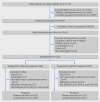Different systolic blood pressure targets for people with history of stroke or transient ischaemic attack: PAST-BP (Prevention After Stroke--Blood Pressure) randomised controlled trial
- PMID: 26919870
- PMCID: PMC4770816
- DOI: 10.1136/bmj.i708
Different systolic blood pressure targets for people with history of stroke or transient ischaemic attack: PAST-BP (Prevention After Stroke--Blood Pressure) randomised controlled trial
Abstract
Objective: To assess whether using intensive blood pressure targets leads to lower blood pressure in a community population of people with prevalent cerebrovascular disease.
Design: Open label randomised controlled trial.
Setting: 99 general practices in England, with participants recruited in 2009-11.
Participants: People with a history of stroke or transient ischaemic attack whose systolic blood pressure was 125 mm Hg or above.
Interventions: Intensive systolic blood pressure target (<130 mm Hg or 10 mm Hg reduction from baseline if this was <140 mm Hg) or standard target (<140 mm Hg). Apart from the different target, patients in both arms were actively managed in the same way with regular reviews by the primary care team.
Main outcome measure: Change in systolic blood pressure between baseline and 12 months.
Results: 529 patients (mean age 72) were enrolled, 266 to the intensive target arm and 263 to the standard target arm, of whom 379 were included in the primary analysis (182 (68%) intensive arm; 197 (75%) standard arm). 84 patients withdrew from the study during the follow-up period (52 intensive arm; 32 standard arm). Mean systolic blood pressure dropped by 16.1 mm Hg to 127.4 mm Hg in the intensive target arm and by 12.8 mm Hg to 129.4 mm Hg in the standard arm (difference between groups 2.9 (95% confidence interval 0.2 to 5.7) mm Hg; P=0.03).
Conclusions: Aiming for target below 130 mm Hg rather than 140 mm Hg for systolic blood pressure in people with cerebrovascular disease in primary care led to a small additional reduction in blood pressure. Active management of systolic blood pressure in this population using a <140 mm Hg target led to a clinically important reduction in blood pressure.Trial registration Current Controlled Trials ISRCTN29062286.
Published by the BMJ Publishing Group Limited. For permission to use (where not already granted under a licence) please go to http://group.bmj.com/group/rights-licensing/permissions.
Conflict of interest statement
Competing interests: All authors have completed the ICMJE uniform disclosure form at
Figures


Comment in
-
Blood pressure targets in primary care.BMJ. 2016 Feb 24;352:i813. doi: 10.1136/bmj.i813. BMJ. 2016. PMID: 26920040 No abstract available.
-
Recurrent stroke.Nurs Older People. 2016 May;28(4):13. doi: 10.7748/nop.28.4.13.s17. Nurs Older People. 2016. PMID: 27125934 No abstract available.
References
-
- Lewington S, Clarke R, Qizilbash N, Peto R, Collins R. Prospective Studies Collaboration. Age-specific relevance of usual blood pressure to vascular mortality: a meta-analysis of individual data for one million adults in 61 prospective studies. Lancet 2002;360:1903-13. 10.1016/S0140-6736(02)11911-8. 12493255. - DOI - PubMed
Publication types
MeSH terms
Substances
Associated data
Grants and funding
LinkOut - more resources
Full Text Sources
Other Literature Sources
Medical
Molecular Biology Databases
Miscellaneous
